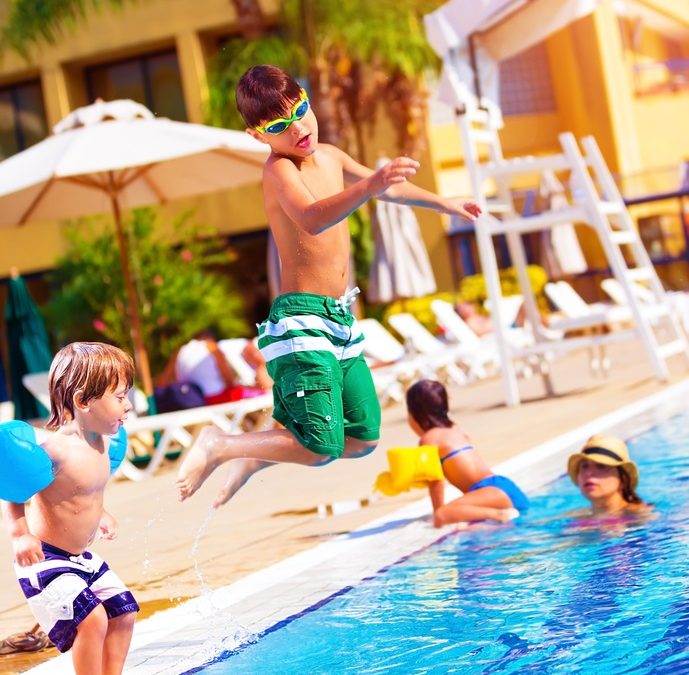If you grew up around water or had a swimming pool when you were a child, you probably either remember how much you loved it or perhaps you were scared of the water. You’re determined to have your children have a healthy respect for the family swimming pool, but you want them to know how to swim and to love being in the pool, right? If that’s the case, you can either teach your children how to swim or you can take them to lessons or you could hire someone to come to your home and teach them right there. It doesn’t really matter where you teach your children to swim, it matters that they have a good time while they’re learning and that they learn to love the water!
One way to assure that your children love the water is to assure you understand what they experience when they see a swimming pool. Remember, to a child a swimming pool can be scary. It’s much larger than the bathtub and in a bathtub they can touch the sides and the bottom and that makes them feel safe. In a swimming pool it’s up to you, as the parent, to teach them how to feel safe and to let them know they can trust you in the pool.
Have a “kicking contest.” Gather poolside, lean on the side of the pool and kick, kick, kick! Whomever kicks and splashes the most is the “winner”! This is a great way to show your kids not only how to kick, but if water splashes in their faces they will learn it’s not as scary as they may have imagined.
Cater to their attention spans
Let’s face it, kids have short attention spans. They are easily distracted and easily bored. When teaching a child to swim you need to keep it fun — and depending on their age — short. You want to assure they remain enthusiastic about being in the pool. If they liken swim lessons to cleaning their room or eating broccoli, it will not be fun for anyone!
Be genuine and make certain you’re fully invested in the swim lessons so that your child feels your enthusiasm and knows you are there 100% and involved with their fun and learning.
The younger you teach your child the better. Ask your family physician at which age your child can learn to swim and go from there. If you’re working with an individual who will be teaching your child to swim, make certain they are accustomed to working with young children — or even babies if that is the age of your child.
Keep Instructions Simple
Instructions should be simple and straightforward. You can use key words such as “Stop, Look, and Listen,” where students repeat what you say and complete the action. Don’t include more than five rules, and make sure to review the rules once in a while so kids don’t forget. Even if you are working with one child, it is important to do this and let your child know behavior expectations. Make sure to use age-appropriate language for the rules.
Be Positive
When you’re teaching your child to swim, or taking him to lessons, make sure the instructor focuses on only one skill at a time. Let your child master that before moving on. Make learning fun and have positive reinforcement for a job well done. You know your child will love it if you’re shouting encouragement from the sidelines — well, they will if they’re young!
Music Adds To The Fun
If there is a certain type of music or movie soundtrack your child loves, have that playing during the swim lessons. Music will help keep them engaged and entertained during the lesson. If they know a certain song and if they’re getting tired of the lesson, tell them, “once this song is done, we are done with the lesson for today.” Give them an end point they can recognize.
 Fun Pool Toys
Fun Pool Toys
If you are teaching older children to swim, teach them to blow bubbles and dive for fun pool toys like “diving sticks.” These sticks are heavy and come in various colors. They can be dropped into the pool and you can engage the children by asking them to go underwater and grab a specific color. Award prizes to the child who gets the diving stick first. Another fun game for older children is to give them a round, flat disk and when they’re learning to float on their backs, ask them to keep the disk on their forehead while they do so. The one who keeps his or her disk on their forehead the longest is the “winner.”
Young love rubber duckies. If your child does, then toss a few different colored and sized ones into the pool and when they’re at the point in their lessons when they can swim a few strokes, help them swim to the ducks.
Pool noodles are always fun! Invest in different colored and sized pool noodles and let your children play with them, float with them and just have fun splashing around.
Drop some pin-pong balls in the water and ask the children who are learning to swim to blow the balls across the water. This will help them get more comfortable in the water and more comfortable with their faces in the water. If you have two children, or more, make it a “race” to get the ping-pong ball from one side of the pool to the next. If you have a young child who hasn’t learned to swim, support him or her and let them participate as well.
Falling In The Water
When your children are comfortable, play the “trust” game with them. Stand in the pool and let them jump into your arms. This is a great way to help a child see that you are there to catch them and that they know enough about the water that they will bob to the top once they go under.
Pool Safety Equipment
Regardless of how well your child has mastered the art of swimming, you want to keep life vests and other pool safety equipment always close at hand in the event of an accident or emergency. If your child is getting tired, but doesn’t want to get out of the water, offer him a life vest so he can stay in and be safe while he’s paddling around.


